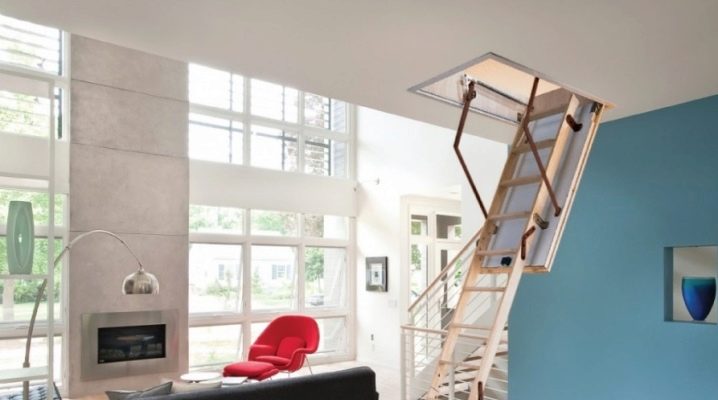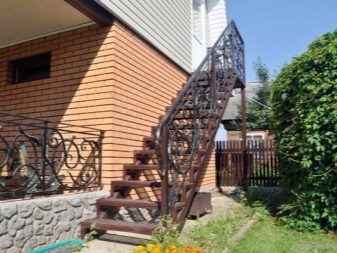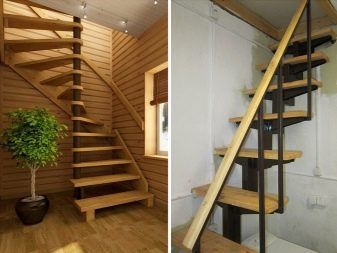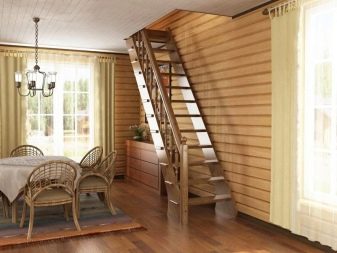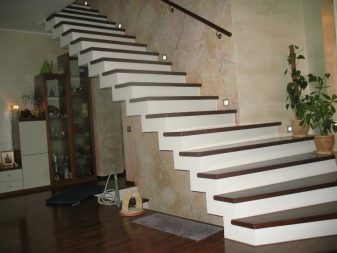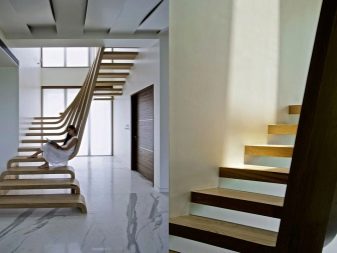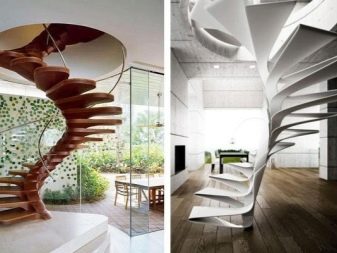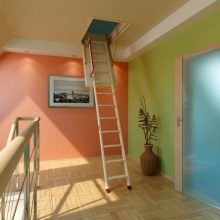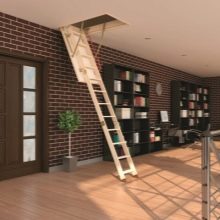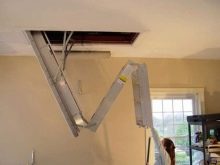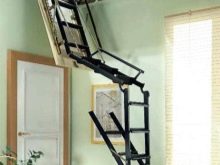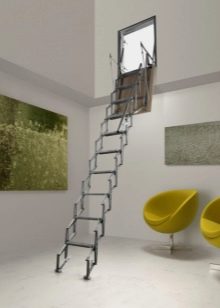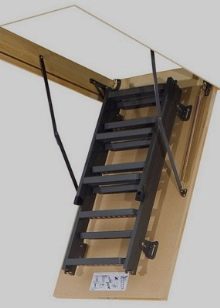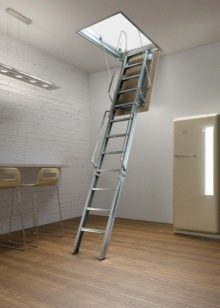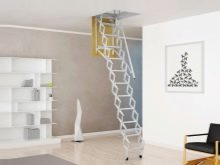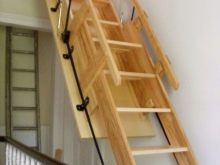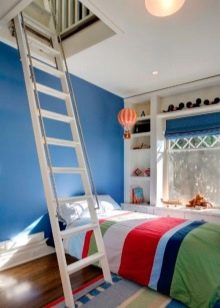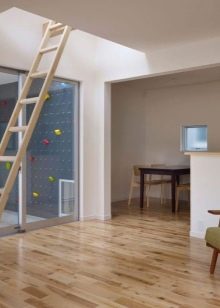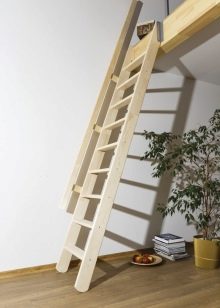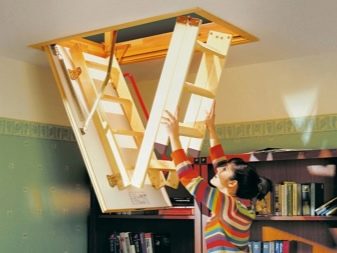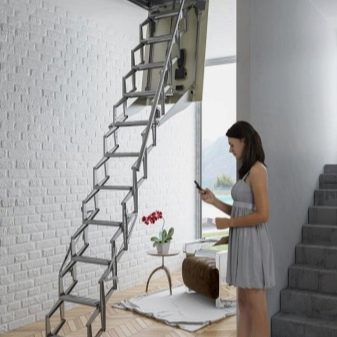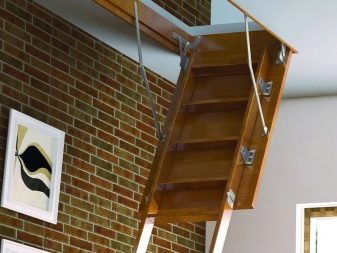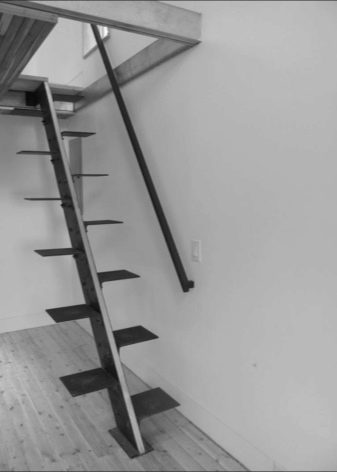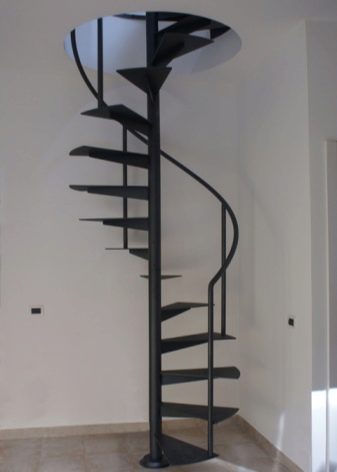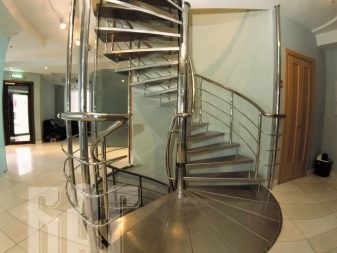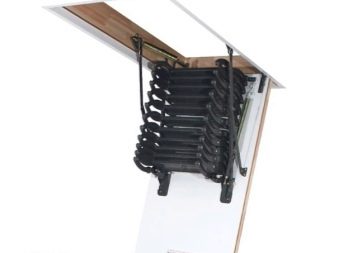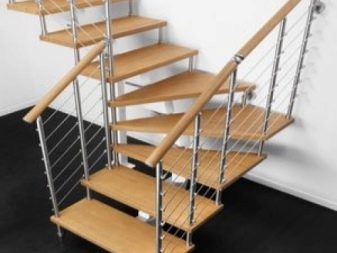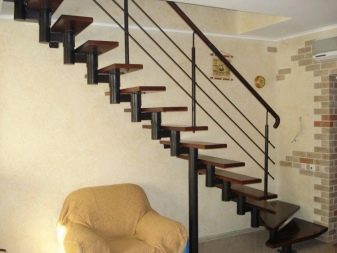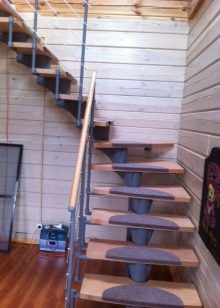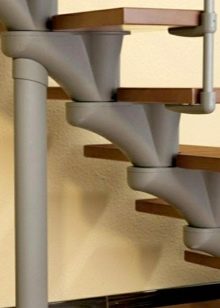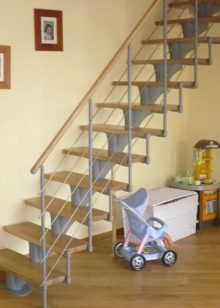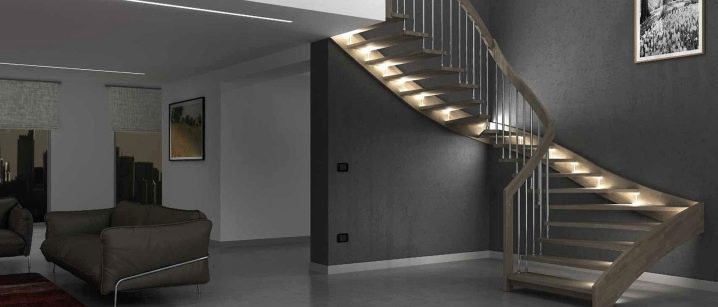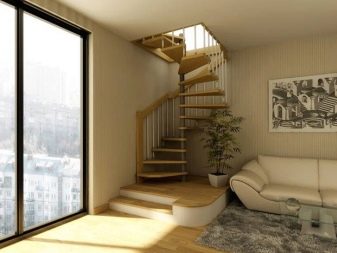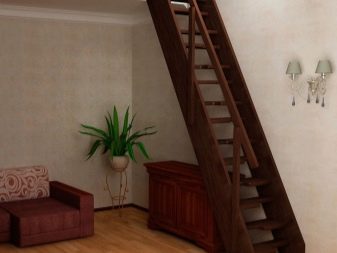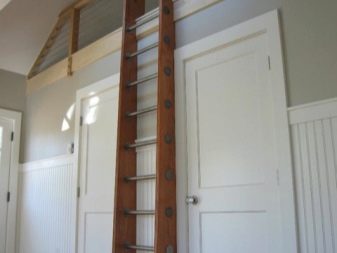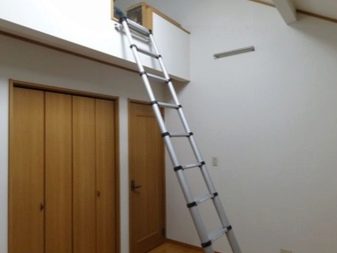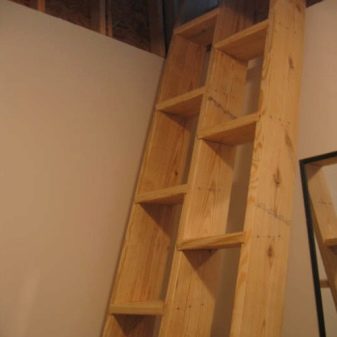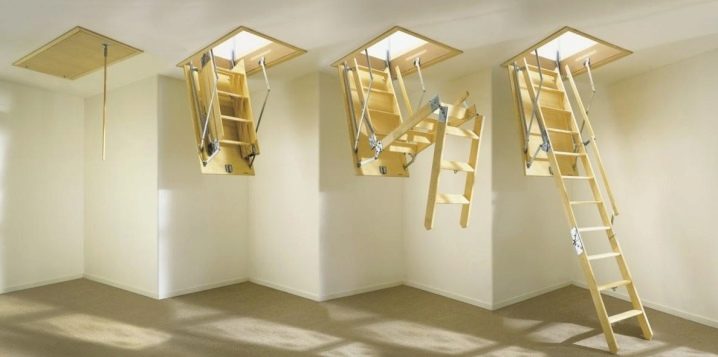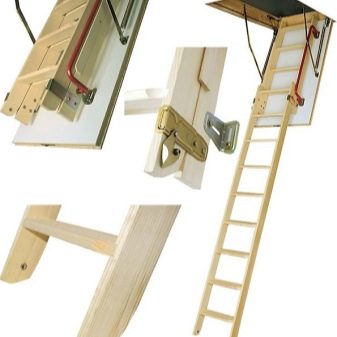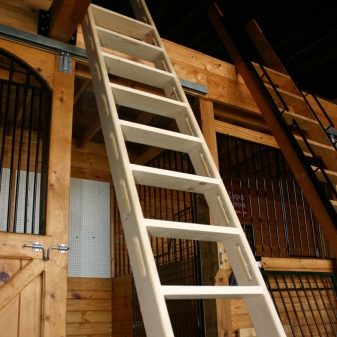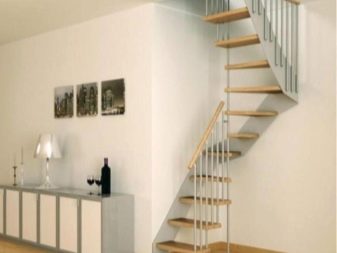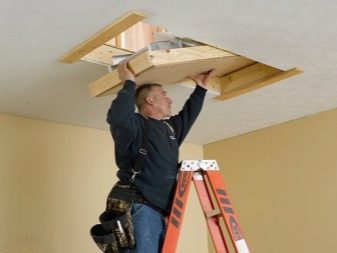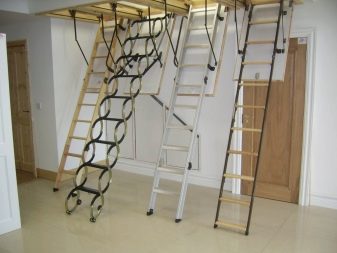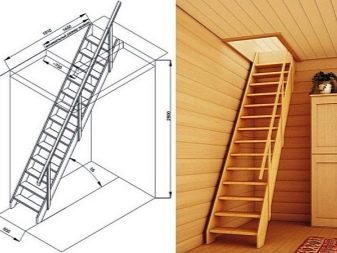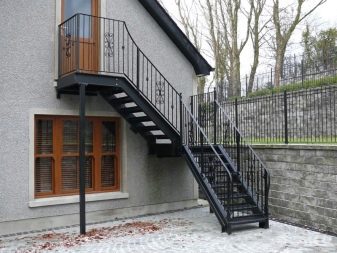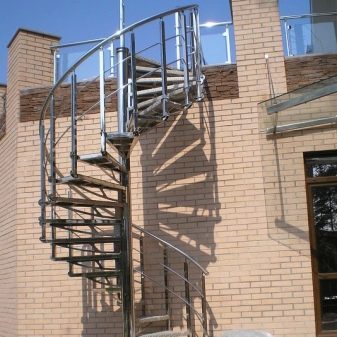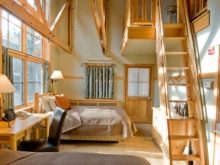Varieties and sizes of attic stairs
In private houses, where there is necessarily an attic, the attic stairs play a big role. It is necessary to pay special attention to the choice of this design.
Modern stores can help with this by offering a rich assortment of various finished products. But it is often difficult to decide which ladder is best to install in the house. Therefore, it is important to learn in advance about the features, types and characteristic features of garret designs.
Special features
The attic is a compartment occupying the upper territory of a private house and connected to the rest of the territory by means of staircase structures. The ladder is installed directly to the entrance to the attic. A tight connection is necessary so that holes do not form where the leg can get stuck.
The staircase can be located in a room connected to the attic, and on the street, forming a "cold" entrance to the attic. The internal design can be made in different variations, but the prerequisite is the harmony of the stairs with the interior of the room.
The product should not stand out from the general concept or fade against the backdrop of catchy design. External variation should be combined with the design of the facade of the building. It is necessary to select the appropriate material that is resistant to various weather patterns.. An important feature of the attic stairs is the degree of their reliability. No matter what method of fixation the structures possess, they must be firmly attached to the attic opening and withstand heavy weight.
Materials, types and sizes
There are many types of staircase designs for the attic. Each of them differs in a number of characteristic features, but they all imply the obligatory presence of a hatch - an attic hole through which access to the attic is provided. The hatch is often also the holder of the attic stairs.
When the choice comes to the stairs, buyers usually consider several varieties, according to the design of the device.
Monolithic
This design is called standard.It is presented in the form of a complex frame with steps, occupying the entire territory from floor to hatch. A distinctive feature of this product is its thoroughness: the ladder cannot be moved or removed if necessary.
Such designs are typical for classic old houses. They often have a complex shape and design, are screw or marching. Sometimes the space under such a structure can perform a separate function (for example, be used as a storage room).
Screw
The spiral staircase is a narrow spiral-shaped structure. Often such a structure is equipped with a railing of a material other than that used to create the frame itself.
Spiral staircases are made of various materials, they are embodied in a variety of styles. This design requires that the room leading to the attic, had a fairly high ceiling.otherwise the staircase bends will look ridiculous.
Foldable
This type of attic construction with the hatch is particularly popular in recent times. It includes many varieties of stair structures.
The staircase itself is a mobile structure, folding in various ways and not cluttering up the space. Folding options are endowed with many interesting mechanisms that allow you to mask the stairs in various ways.
Folding
Such models have a rather complicated construction. They do not depend on the attachment to the hatch, as they are folded into the wall..
With the help of special card loops, the steps are fixed. This staircase allows you to save space.
Sliding
Not less popular are the sliding attic staircase mechanisms. The staircase is divided into sections, which are connected to each other by means of metal tubes. Particularly popular is the three-section design.. When assembled, it is difficult to notice the precise positioning of the steps of such a staircase, they are accurately fixed in the disassembled state, with each step clearly located in its place.
This staircase is not among the most sustainable, it has certain weight limits.
With telescopic mechanism
Among the sliding ladders, the designs withtelescopic mechanism. The essence of such a structure is that in the folded state sections are one in another.
When the ladder needs to be disassembled, the sections are moved forward alternately (like a telescope mechanism). The thickest parts are the lower ones, it is in them that the remaining sections are placed during assembly (the higher the section, the thinner its frame). When the staircase is assembled, it takes up little space.
Retractable
In another way, such a ladder is called an accordion or scissor. Its sections are presented in the form of rhombuses or ovals, in a special way fastened together. The method of compression of this design resembles the mechanism of compression harmonies.
Most often, such a light construction is made of metal, it needs careful care, so that when disassembling the staircase does not emit a squeak.
Attachment
This type of ladder includes direct portable structures or stepladders. They are placed at a certain angle under the attic and, if necessary, removed.
Disassembly type
Stairs to the attic are classified according to the method of disassembly. Consider the basic mechanisms.
Manual
With the help of a special cane mounted in the ceiling, the assembled structure is hooked onto a special hook and pulled over.Often it is not necessary to apply large forces in order for the ladder to come to its working position.
With drive
Motorized ceiling products allow the automatic extension of the staircase via remote control.
This method is especially convenient if your house has a high ceiling.
Material
In addition to the main options for the device ladder an important feature in the division of products into groups is the material from which the product is made. There are several types of raw materials for the production of attic stairs.
Tree
Wood is the most popular material for the manufacture of stairs. It is made from complex structures such as spiral staircases and compact folding models. The most affordable option is pine, sometimes in the production of using maple or oak wood.
The structures are quite strong and solid, however, in certain conditions, the stairs can rot. To avoid this, it is necessary to periodically process the stairs with special compositions or apply a protective coating on it. Do not forget about the means against tree parasites.
Metal
The second most popular material is metal. It is used primarily to create stairs leading to the attic from the street. Inside the house such a design would be appropriate if it is combined with a certain style of interior. The undeniable advantage of the metal is its durability, but in conditions of high humidity on the stairs rust and corrosion may appear (in case of using special ferrous metal).
It is necessary to cover buildings with special anti-corrosion compounds.. In contrast to the wooden system, the ladder of metal is not so easy to make yourself. The metal staircase does not suffer from fire; in case of fire, it will not make it difficult to exit from the attic.
Consider the relevance of different materials:
- Stainless steel Popular for folding ladders. It has a light weight and high resistance to moisture. Such structures must be periodically lubricated to ensure that the mechanisms operate silently.
- Aluminum can be seen in the retractable attic structures with a telescopic mechanism. This material is used because of its low weight.This creates additional convenience in the operation of the stairs.
- For certain parts of the structure (steps or railings) additional materials are used: rubber and PVC. They help to avoid unnecessary sliding on metal structures. Creating a stronger grip with different soles of shoes and hands, such protection mechanisms do not allow to slip on the stairs and get injured.
- The combined staircase is popular in the design of the space between the room and the attic. Such a ladder may consist from a combination of wood and metal, sometimes wood looks appropriate with glassThere are a combination of wood and stainless steel. All these combinations open a huge scope for fantasy. Due to the combination of materials, the staircase can become a bright accent of the interior.
Size selection
Another important feature of attic stairs to which attention should be paid is the size of the product.
In order not to be mistaken with the dimensions, in addition to the possible weight load on the product, you need to take into account a number of nuances.
Ceiling height in the room
If the structure is too large, its rigidity is violated, it becomes unsafe to walk on such a structure. The minimum number of steps is usually 13 pieces, and the maximum comes to 16 pieces.
The angle of the stairs
He should not go beyond range limits from 65 to 75 degrees. With a larger value, the degree of safety of the device is significantly reduced, with a smaller design itself looks unpresentable.
Growth and step width of households
This indicator affects the height and width of the steps. The distance between the steps is determined by the standard, given the average length of a human step, it is usually just over 19 cm.
Only with all of the above parameters, you can take care of the beautiful view of the stairs to the attic and their safety during its operation.
Advantages and disadvantages
Each of the models of stairs leading to the attic has its pros and cons, which you need to know before buying a specific option.
Monolithic designs are distinguished by a number of advantages. We note the main ones:
- Since the products are made of durable materials and have a fairly dense frame, they are difficult to deform during operation. Such species with proper care retain their shape, size and presentability for much longer than folding structures.
- Having an unusual appearance, monolithic products make a strong impression on guests and give aesthetic pleasure. Due to such structures, you can emphasize the status of the owner of the house and give the dwelling a luxurious look.
- In the manufacture of such ladders allowed the greatest variety of materials. If in other cases the construction is mainly steel or wood, in the case of a monolithic product, various decorative materials are used, including metal and glass.
Non-standard options have drawbacks:
- They occupy additional space. Such facilities require a lot of space, the premises should be quite large. This is especially necessary if you want to install a spiral staircase in the attic.
- Such large products are often very expensive, especially if they are made of high-quality and expensive materials.
Attachments, although used temporarily during repairs, have a number of pros and cons.
Denote the positive features:
- Mobility. Such ladders can be removed after use in a place specially designated for their storage, this allows saving space.
- Cheapness. Attached models are made from simple materials.They are not equipped with additional decoration and decor, so their prices are quite low.
- Principle of use Such structures are optimally simple. It is enough to attach the product at the required angle to the attic hole or disassemble the structure itself to a stable position (in the case of a stepladder).
- In case of damage to the product easy to repair, since there is no need to detach the ladder from the mounting mechanism, work can be carried out at any place convenient for you.
There are drawbacks in the attached structures:
- Not always the ladder is easy. Some wooden products have a very impressive weight, not every household can bring the product to the attic hatch independently.
- The safety level of the attached structures is low.. When fuzzy fixation with a support, the ladder can change the angle of inclination, lose stability, or even collapse. Not always such structures have a clear attachment with the hatch.
Folding ladders, which are gaining more and more popularity, also have their positive and negative qualities:
- Such products save space as much as possible.When folded, they can be removed into the hatch, creating a perfectly flat ceiling. This ability allows you to not clutter up the room.
- Because of the possibility of equipping structures with electric drive, they are easy to use. Even with a mechanical disassembly method, the layout of the stairs does not take much time.
- Since the ladder is firmly fixed on the very opening of the hatch, greater safety is ensured during its operation.
- Most of the folding structures are lightweight compared to the attached counterparts. When mechanical disassembly does not need a lot of effort to bring the product in working condition.
- Ladders of folding type approach to a large number of the style directions (from a country to hi-tech). This allows you to choose a design that fits perfectly with the concept of the interior.
- In comparison with monolithic models it can be noted that the price of a folding product is democratic. A lot of material is not spent on the production of one ladder, such products do not require large financial expenditures.
- With the help of special finishing of the hatch, you can create a warmed zone in the ceiling.At the same time the ladder compactly cleans up, creating an esthetic look indoors and keeping heat in the room.
There are also negative features:
- To install the mechanism in most cases you need to seek help from specialists.
- In the event of a breakdown of the stairs (especially if the structure is equipped with an electric drive) it will be difficult to repair it.
Tips for choosing
To choose a finished attic ladder of any type competently, you need to listen to the recommendations of specialists who have derived certain criteria for choosing stairs leading to the attic.
Note the main landmarks:
Security
Special attention should be paid to her if your family has small children or elderly household members. In this case, it is imperative to consider such factors as the presence of a handrail and the possible risk of slipping on the surface of a certain material.
Compactness
This criterion depends on how important it is for you to hide the attic opening. This priority will determine whether the structure will be visible from the room, or it will be completely hidden behind the hatch.
The convenience of use
Consider choosing such a mechanismso that all family members, regardless of their height and build, can use the device themselves. Attention should be paid to lightweight aluminum products.
Installation
Not for all models easy to install in the opening. Calculate your strength more carefully. Consider all the features of the room that may interfere with the installation of various structures.
Design
Make sure that the design of the staircase corresponds to the concept of the interior of the room in which it will be located.
Price
Cost is an important factor. It determines the number of product options that you can consider as a potential acquisition.
Features box hatch
It is better to choose a warming box that will not let the cold air into the room bordering the attic. If you live in a warm climate, you can ignore this recommendation.
Calculation of parameters
Regardless of whether you choose a structure or metal from a tree, it is important to take into account a number of parameters to help create the perfect entrance to the attic.
- Maximum allowable height products should not exceed 350 cm.
- Standard opening sizes for the hatch is 80 x 70.
- Minimum permissible angle tilt equals 55 degrees.
- Consider the type of attic openingwhich can be ceiling, wall or corner.
With all the necessary indicators, you can choose the perfect stairs to the attic or attic. Even with a minimal deviation from some parameters, other indicators may change.
How to arrange?
There are various options for the location of structures leading to the attic. They depend on the location of the structure itself. Street stairs are usually located along the wall of the house so as not to intersect with window openings. This requires a large area, so in most cases such a structure is made from the side of the house where there is a minimum of windows. It is important to equip a small platform in front of the entrance to the attic, be sure to provide it with railings.
If at home the spiral staircase looks cumbersome, such a construction will suit the street much more. The staircase is not so large in length, so it is allowed to be installed on the side where there are windows, it may well take a distance between them.
When installing the stairs to the attic, please note that she should not interfere with the movement of the room. Monolithic stairs are usually installed in a corner or along a wall without windows. The location of the hatch significantly affects the location of mobile structures.
If the staircase is compact, it can be installed in almost any part of the room. Do not place a folding ladder directly in front of the doorway: so entering the room, you can hit the disassembled device.
Tips and tricks
Summarizing all the recommendations of experts and experienced users, you can make a list of universal tips for choosing and installing stairs in the attic:
- Consider the features of the layout of the house.
- Take into account the frequency of operation of the stairs to the attic.
- Check the compatibility of the product with the interior of the room before buying.
- Use products from trusted manufacturers only, having previously studied reviews about firms.
- Take care of your own safety when choosing a design.
Taking into account all the listed tips, requirements and characteristics, you will be able to choose the ideal model of stairs in the attic,which will be a functional interior detail and interestingly complements the decor of the room.
The process of installing an attic staircase, see the following video.
